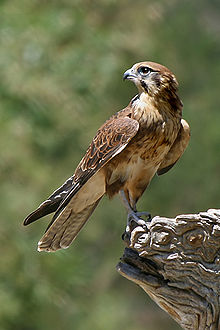Falconinae
| Falcons and caracaras Temporal range: Early Eocene – Holocene, 50–0 Ma |
|
|---|---|
 |
|
|
Brown falcon Falco berigora |
|
| Scientific classification | |
| Kingdom: | Animalia |
| Phylum: | Chordata |
| Class: | Aves |
| Order: |
Falconiformes Sharpe, 1874 |
| Family: |
Falconidae Vigors, 1824 |
| Subfamilies | |
The falcons and caracaras are around 60 species of diurnal birds of prey that make up the family Falconidae. The family is divided into two subfamilies, Polyborinae, which includes the caracaras and forest falcons, and Falconinae, the falcons, kestrels and falconets (Microhierax and Spiziapteryx). They differ from the eagles of Accipitridae, in that falcons kill with their beaks instead of their taloned feet. They have a "tooth" on the side of their beak for the purpose.
Falcons and caracaras are small to medium-sized birds of prey, ranging in size from the black-thighed falconet, which can weigh as little as 35 grams (1.2 oz), to the gyrfalcon, which can weigh as much as 1,735 grams (61.2 oz). They have strongly hooked bills, sharply curved talons and excellent eyesight. The plumage is usually composed of browns, whites, chestnut, black and grey, often with barring of patterning. There is little difference in the plumage of males and females, although a few species have some sexual dimorphism in boldness of plumage.
The family has a cosmopolitan distribution across the world, absent only from the densest forest of central Africa, some remote oceanic islands, the high Arctic and Antarctica. Some species have exceptionally wide ranges, particularly the cosmopolitan peregrine falcon, which ranges from Greenland to Fiji and has the widest natural breeding distribution of any bird. Other species have more restricted distributions, particularly island endemics like the Mauritius kestrel. Most habitat types are occupied, from tundra to rainforest and deserts, although they are generally more birds of open country and even forest species tend to prefer broken forest and forest edges. Some species, mostly in the genus Falco, are fully migratory, with some species summering in Eurasia and wintering entirely in Africa, other species may be partly migratory. The Amur falcon has one of the longest migrations, moving from East Asia to southern Africa.
...
Wikipedia
